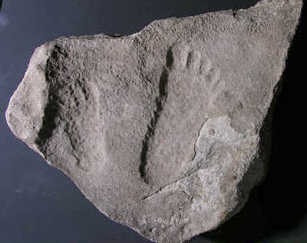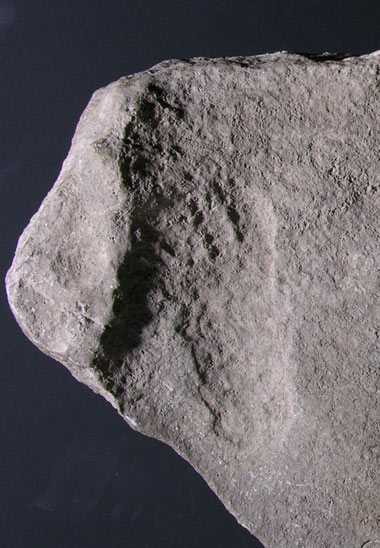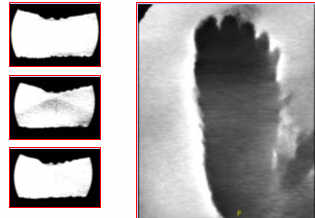

|
| A. M. Coffee Track |
Part of Kuban's Paluxy web site

|
| "Adult" A. M. Coffee Track close-up Note apparent lack of natural bottom contours (no distinct arch or significant depression for ball or heel) |
The CEM website stated that Coffee "worked one of the tracks loose," which he then showed to his boss and friends, after which "various interested persons took the rest of the tracks" (Baugh, 2006).

|
| Cast of the Coffee track, displayed
in June 2006 at Baugh's Creation Evidence Museum in Texas. Note lack of proper bottom contours. © 2006, Glen Kuban |
According to Baugh, the Coffee print, which he incorrectly calls an "artifact." (if real, it would be a trace fossil, not an artifact), "created an instant controversy among archaeologists, geologists and anthropologists, because the sedimentary rock system of the entire area is geologically assigned Permian (assumed to be 225 million years old)." As is common in Baugh's writings, he has misunderstood the mainstream date. The Permian is dated at approximately 290-245 million years ago, not 225. One might wonder, if the print was such a topic of legitimate controversy as Baugh implies, why Baugh does not cite any scientific or even popular literature regarding it. Even more curious is the apparent lack of previous, detailed creationist work and writings on the specimens in question, especially if it has been known by creationists for as long as Baugh indicates. Likewise, Baugh makes no mention of any in situ photographs, maps, or other field documentation being done by anyone connected with the find. This seems very curious if the tracks ever belonged to a natural striding sequence in rock, and were quickly recognized as a stupendous find, as Baugh implies.
Baugh states that "the general consensus was that the print had to be a carving made by Indians, or the like." Presumably he is referring to mainstream scientists here, since evidently Coffee and other laymen did not share this view. He then attempts to refute the carving interpretation by noting that the tracks were not "stylized" as other Indian carvings are. He asserts that they show complete arches and distinct ball and heel impressions. However, as can be seen in the photographs, the bottom is essentially flat, and does not show anything approaching natural bottom contours (which would include distinct ball, arch, and heel relief). This was confirmed when I inspected a cast of the print in person in June 2006. In describing the Coffee print, Baugh states that it is 3/4 inches deep. However, one could not give a single, "flat" measurement if it showed normal bottom contours; instead one would give separate depth measurements for the each portion of the print.
In terms of the overall shape, while the coffee print's outlines are well delineated, it shows a number differences from a natural human print. Besides the lack of normal bottom contours, it should show more of an instep, and the smallest two toes should be more dot-like. Also, the toe line should form more of an angle.
The smaller print on the same slab is less well defined, especially in the toe area. Like the larger one, it appears to show a largely flat bottom, rather than distinct heel, arch, and ball contours. More details about the expected features of real human prints are given in Laurie Godfrey's article "Footnotes of An Anatomist" (Godfrey, 1985).

|
| Supposed "child" print on Coffee slab |

|
| CT scans claimed by
CEM to show compression features |
Baugh also noted that the staff also observed three arches (medial, lateral, and metatarsal), and the overall distinctive shape of the human foot." He later also says they noted the distinctive "ball" of the foot. However, as already noted, and as can be plainly seen in the photos, the track is largely flat on the bottom, and lacks distinct ball arch and heel contours. The CEM website added a photo in Feb. 2002 with supposed arches labeled, but the captions were just overlaid on the same images previously shown, and do not demonstrate any such arches.
Baugh continues, "Attention was drawn to the depressions made by the dominant "great toe," the unique "second toe" that makes a slightly deeper depression, and the distinctive "ball" of the foot. When the analysis was complete the CT Scan had recorded the compression around the complete footprint, clearly indicating that the print was not carved or fabricated. In CT Scan X-rays the lighter areas are more dense, since the X-rays have more difficulty traveling through that medium."
The above remarks seem inconsistent with the scans Baugh has so far presented, and are reminiscent of Baugh's previously exaggerated statements about CAT scan results on his alleged Cretaceous finger (Kuban, 2005). In that case he claimed scan films showed clear human bones and ligaments, when no such distinct features can be seen on the scans themselves.
Baugh emphasizes that the Coffee slab shows "a thin crustal layer of sediment formed over the bulk rock as both layers lithofied. The crustal layer followed the contour of the contour of the depression. This thin layer is clearly seen, since a section of it peeled off as Mr. Coffee was removing the artifact. Any carving activity would have cut through the outer layer, clearly leaving its evidence of fabrication." This is the most interesting aspect of this alleged human track. Indeed, if this "crustal layer" was part of the original rock surface, it would tend to argue against a carved origin, since the layer appears thinner than the depth of the print. However, the above statement involves a big "if." A key question is whether the surface lamination is the same age as the rest of the block. We cannot take this for granted. Indeed, there are any number of tracksites (including areas of the Paluxy) where an ancient track bed has become encrusted with a thinner layer of firm but relatively modern sediment and/or algal laminations. These encrustations can become quite hard, and sometimes give the false impression of being part of the of the underlying rock bed. It is also possible that the rock might have been deliberately coated with some modern material (perhaps in an effort to protect it). In either case, if the surface lamination is relatively recent, then it would provide no argument whatsoever for the authenticity of the print. Considering Baugh's track record, he would do well to allow someone with more geologic expertise and credibility to study the print and address this issue.
Beyond the above issues, a major problem for this alleged human print is that only anecdotal evidence has been presented for the source locality and geologic context. Without disparaging the Coffee family or their recollections, in order for this print to be taken seriously by scientists, we would need verifiable documentation that it came from a Permian or other pre-Quaternary formation. Evidence for this might be provided by detailed study of the lithology and any fossil evidence (especially microfossils) in the rock itself, but evidently so far this has not been done. Even if it were established that the rock was Permian, we would further need to establish that the print was not carved, and that the encrustations supposedly proving this are the same age as the underlying rock. Baugh has made assertions about compression and bottom contour features shown by CAT scans, but images so far displayed do not lend support to this claim. Indeed, the only photographs and scans shown appear to contradict some of his assertions.
The Coffee print appears somewhat more human-like than many previously claimed human tracks in ancient rock, but shows a number of unnatural features, and has not been reliably associated with any specific rock formation. In view of these serious shortcommings, it cannot be regarded as a reliable out-of-place fossil.
Baugh, Carl E, 2006, "What's New at CEM" article on Coffee Print at: http://www.creationevidence.org/cemframes.html
Godfrey, Laurie, 1985, "Footnotes of an Anatomist," Creation/Evolution, Issue 15, Volume 5, Number 1 (Winter 1985)
Kuban, Glen J., 2005, Website article: An Alleged Cretaceous Finger, at http://paleo.cc/paluxy/finger.htm
* Evidently to bolster Fred Coffee's credibility, Baugh mentions that he is a member of the City Council of Stinnett. For the record, Coffee did serve four terms on the council but was defeated in the May 2006 election. At any rate, Coffee's credibility does not depend on whether he is still a council member or not. Any questions about the Coffee prints are more likely to relate to their geologic context and whether or not they were carved. If they were, it likely took place decades or centuries before the elder Coffee discovered them.